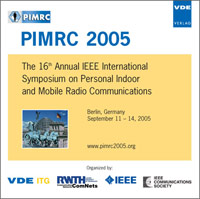Another double tier to avoid local congestion in a unified microcellular network
Konferenz: PIMRC 2005 - 16th Annual IEEE International Symposium on Personal Indoor and Mobile Radio Communications
11.09.2005 - 14.09.2005 in Berlin, Germany
Tagungsband: PIMRC 2005
Seiten: 5Sprache: EnglischTyp: PDF
Persönliche VDE-Mitglieder erhalten auf diesen Artikel 10% Rabatt
Autoren:
Yamada, Takahiko (Ritsumeikan University, 1-1-1 Noji-Higashi, Kusatsu-shi, 525-8577, Japan)
Inhalt:
This paper proposes a unified micro-cellular network for future multimedia communications, and proves that its capacity can be several thousand times bigger than today’s widely accepted double-tier architectures in which low speed terminals are accommodated in micro-cells whereas fast terminals are served in overlapped macro-cells. In the unified micro-cellular network, micro-cells are deployed along major roads of a metropolitan area to offer high bit-rate packet transfer to fast moving terminals. A set of polling is emitted in parallel in several adjacent micro-cells, configured to a Logical Macro-Cell (LMC), and the LMC formation is changed following the movement of the fast terminal (more than 100km/h) to avoid frequent handovers. Moreover, to prevent local congestions which can easily happen in cells of e.g. a road junction, a new double-tier structure is proposed so that Pico-cells are included in micro-cells with frequent local congestion. Pico-cell does not affect neighbor-cells, since it is enclosed in the target micro-cell. The capacity increase of the target micro-cell depends on the size and the channel number of each deployed Pico-cell.


